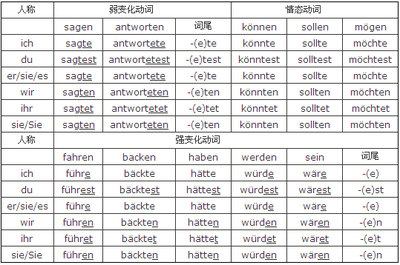The Present Subjunctive I
In German, the present subjunctive I tense is usually calledKonjunktiv I Präsens, or simply Konjunktiv Präsens.Other English names include the “present subjunctive,” “presentsubjunctive, primary,” and “special subjunctive.”
The present subjunctive I is formed by addingsubjunctive endings to the infinitive stem.
lachen to laugh (STEM lach-)fahren to drive (STEM fahr-)
ich lachewir lachenich fahrewir fahren
du lachestihr lachetdu fahrestihr fahret
Sie lachenSie lachenSie fahrenSie fahren
er/sie/es lachesie lachener/sie/es fahresie fahren
• All present subjunctive I endings begin with -e-. Theich and er/sie/es endings are made up only of-e. This -e- is a characteristic feature of presentsubjunctive I.
• Endings are the same for all verbs exceptsein; some verbs, however, are adjusted as follo ws.
• If the infinitive stem ends in -ie, all endings dropthe characteristic -e-, since the stem already ends in-e, as shown with the verb knien below.
• If the infinitive stem ends in -el or -er, allendings drop the characteristic -e- except in the ichand er/sie/es forms, as shown with the verbwandern.
knien to kneel (STEM knie-)wandern to hike (STEM wander-)
ich kniewir knienich wanderewir wandern
du kniestihr knietdu wanderstihr wandert
Sie knienSie knienSie wandernSie wandern
er/sie/es kniesie kniener/sie/es wandere sie wandern
• The verb sein has the following forms inthe present subjunctive I.
sein to be, exist (STEM sei-)
ich seiwir seien
du seiestihr seiet
Sie seienSie seien
er/sie/essei sie seien
Uses of the Present Subjunctive I Tense
The present subjunctive I tense is used in standard and formalGerman for indirect speech that relates presently occurringaction.
Laut Angaben sei er der Täter.According to sources, he is the perpetrator.
Julia sagt, sie habe drei Gründe.Julia says she has three reasons.
If the present subjunctive I form is indistinguishable from thepresent (indicative) tense form, then the present subjunctive IItense is used instead. Furthermore, in colloquial German, presentsubjunctive I is rarely used at all; present subjunctive II tendsto be used for all indirect speech. See “Uses of the PresentSubjunctive II Tense” on page 17.
The Present Subjunctive II
Because the form of this tense is based on the simple past form,it is called Konjunktiv II Präteritum orKonjunktiv Imperfekt in German and sometimes called “simplepast subjunctive” or “past subjunctive” in English. This canbe misleading, however, because the tense expresses time in thepresent. Other names in English include the “general subjunctive”and “present subjunctive, secondary.”
Regular Weak Verbs For regular weak verbs, the presentsubjunctive II is identical to the simple past (indicative) (seepage 12).
Strong Verbs For most strong verbs, the presentsubjunctive II is formed by adding subjunctive endings to thesimple past stem. If the simple past stem vowel is a,o, or u, then an umlaut is added to the vowel.
halten to holdgeben to give
(SIMPLE PAST STEM hielt-)(SIMPLE PAST STEM gab-)
ich hieltewir hieltenich gäbewir gäben
du hieltestihr hieltetdu gäbestihr gäbet
Sie hieltenSie hieltenSie gäbenSie gäben
er/sie/es hieltesie hieltener/sie/es gäbesie gäben
• If the simple past stem of a strong verb ends in -e,the endings generally lose the beginning -e- so as not tohave two es in a row. For example, the simple past stem ofthe verb schreien is schrie, but the ich formof the present subjunctive II is more commonly schrie thanschriee, although both are used.
• A few strong verbs have a stem vowel for the presentsubjunctive II that is different from that of the simple past stem.Others can take either of two stem vowels. Some of the more commonverbs that follow these patterns are shown below, along with theirfirst-/thirdperson singular forms.
INFINITIVESIMPLE PAST PRESENT SUBJUNCTIVE II ENGLISH
sterbenstarbstürbeto die
verderbenverdarbverdürbeto spoil
werfenwarfwürfeto throw
geltengaltgölte/gälteto be valid
gewinnengewanngewönne/gewänneto win
helfenhalfhülfe/hälfeto help
stehenstandstünde/ständeto stand
Note that these exceptional forms are avoided by modern speakerseven in standard German; the würde _ infinitive constructionis used instead (see page 19).
Mixed Verbs Mixed verbs in the present subjunctive IIshare aspects of both regular weak verbs and strong verbs. Likeregular weak verbs, they have the tense marker -t-, but somealso have a stem vowel change or umlaut like strong verbs. Mixedverbs are conjugated according to four patterns.
bringen to bringdenken to think
ich brächtewir brächtenich dächtewir dächten
du brächtestihr brächtetdu dächtestihr dächtet
Sie brächtenSie brächtenSie dächtenSie dächten
er/sie/es brächte sie brächtener/sie/es dächtesie dächten
kennen to knowsenden to send
ich kenntewir kenntenich sendetewir sendeten
du kenntestihr kenntetdu sendetestihr sendetet
Sie kenntenSie kenntenSie sendetenSie sendeten
er/sie/es kenntesie kenntener/sie/es sendete siesendeten

• The verbs brennen, nennen, and rennenconjugate like kennen. The verb wenden conjugateslike senden.
Modal Verbs The present subjunctive II formsof the modal verbs are like those of the simple past, but with anumlaut added to the stem vowel, except for sollen andwollen, whose forms are identical to the simple past.
dürfen to be allowed tokönnen can, to be able to
ich dürftewir dürftenich könntewir könnten
du dürftestihr dürftetdu könntestihr könntet
Sie dürftenSie dürftenSie könntenSie könnten
er/sie/es dürftesie dürftener/sie/es könntesie könnten
mögen to like (to)müssen must, to have to
ich möchtewir möchtenich müsstewir müssten
du möchtestihr möchtetdu müsstestihr müsstet
Sie möchtenSie möchtenSie müsstenSie müssten
er/sie/es möchte sie möchtener/sie/es müsstesie müssten
sollen should, to be supposedtowollen to want (to)
ich solltewir solltenich wolltewir wollten
du solltestihr solltetdu wolltestihr wolltet
Sie solltenSie solltenSie wolltenSie wollten
er/sie/es solltesie solltener/sie/es wolltesie wollten
The Verbs haben, sein, tun, werden, andwissen In the present subjunctive II of the verbshaben, sein, tun, werden, andwissen, the forms are similar to those of the simple past,but with an umlaut added.
haben to havesein to be, exist
ich hättewir hättenich wärewir wären
du hättestihr hättetdu wärestihr wäret
Sie hättenSie hättenSie wärenSie wären
er/sie/es hättesie hättener/sie/es wäresie wären
tun to dowerden to become
ich tätewir tätenich würdewir würden
du tätestihr tätetdu würdestihr würdet
Sie tätenSie tätenSie würdenSie würden
er/sie/es tätesie tätener/sie/es würdesie würden
wissen to know
ich wüsstewir wüssten
du wüsstest ihr wüsstet
Sie wüssten Sie wüssten
er/sie/es wüsstesie wüssten
Uses of the Present Subjunctive II Tense
Irrealis The present subjunctive II can be used todescribe present or future hypothetical or contrary-to-factconditions or actions.
Wenn Uwe morgen käme, wären wirIf Uwe were to come tomorrow,
sehr glücklich.we’d be really happy.
Lea tut, als ob sie den Grund nichtLea acts as though she doesn’t know
wüsste. the reason.
Wishes The present subjunctive II can beused to express wishes.
Wenn es nur nicht so kalt wäre! If only it weren’t so cold!
Ich wünschte, ich könnte gut malen. I wish I could paint well.
Politeness Requests and questions can be made more politewith the use of the present subjunctive II. This applies especiallyto haben, sein, wissen, and the modalverbs.
Ich hätte gern ein Stück Käsekuchen.I would like a slice of cheesecake.
Wüssten Sie, wie viel Uhr es ist?Would you know what time it is?
Indirect Speech In standard and formal German, thepresent subjunctive II tense is used in place of presentsubjunctive I for indirect speech to relate presently occurringactions, but only if the present subjunctive I form isindistinguishable from the present (indicative) form.
Laut dem Bericht kämen sie ausAccording to the report, they come from
Hamburg.Hamburg.
Julia sagt, sie hätten drei Gründe.Julia says they have three reasons.
In colloquial German, however, the present subjunctive II tensecan be used for all indirect speech, even in instances whenthe present subjunctive I is used in formal German.
Leon meint, du wärest dafür zuständig.Leon says you’re responsible for that.
Julia sagt, sie hätte drei Gründe.Julia says she has three reasons.
In colloquial German—and to some extent in standard German—thepresent subjunctive IItense is widely used only with a few commonverbs, including haben, kommen, sein,tun, werden, wissen, and the modal verbs. Formost verbs, spoken German tends to use the future subjunctive IItense but with a present meaning, more commonly known as thewürde+ infinitive construction. For details, see page 19. 爱华网
爱华网


